

 中文摘要:
中文摘要:
光度特性测量是获取空间目标的物理特性的重要技术手段之一,无论是光变曲线的事后分析还是建立光度变化的仿真模型,都离不开一个重要的参数——太阳相位角(太阳-空间目标-测站的空间夹角).目前空间目标的位置通常是通过双行根数(TLE)外推获得,存在一定误差,且随外推时间的延长而变大,因而有必要对其计算所得的太阳相位角的精度进行评估.以典型的不同高度的激光测距卫星LAGEOS1、AJISAI、STELLA为研究对象,以全球激光测距资料解算所得的高精度轨道作为参考轨道,对2012年全年利用双行根数计算所得的太阳相位角数据进行了比对分析,结果表明对于LAGEOS1、AJISAI这样的中高轨卫星,由于轨道较高,表征阻力的B*恒定,计算所得的太阳相位角偏差较小,角分量级,且随外推时间的延长不会导致偏差明显增大;而对于STELLA这样的低轨卫星,因轨道较低、受变化的大气的影响显著,计算所得的太阳相位角偏差较大,尤其是当B*比较大、变化较快时,偏差显著变大,且随外推时间的延长显著增大,在最差情况下:外推1d约为13',外推3d约为50',外推7d约为251',已超出目前的精度要求.因此,在事后分析中应尽可能使用1d之内的TLE计算太阳相位角,对于B*较大且变化较快情况尤其需要注意.另外,针对UTC闰秒的情况,提出了一种处理方法,即在双行根数外推时判断外推时段是否跨越了闰秒时刻,若跨越了则进行修正:增加或减少1s,相应地需要修改结果对应的时间戳计算方法.
 英文摘要:
英文摘要:
Photometry is one of the most important techniques to analyze physical characteristics of space objects. Mter-event analyses of photometric light curves of space objects and construction of their physical models all involve the solar phase angle, a parameter defined as the angle between the light incident onto an observed object from the sun and the light reflected from the object. Currently, the position of a space object is usually calculated with a Two-Line-Element (TLE) set. A position so calculated contains a systematic error increasing with the time elapsed from the TLE epoch. This raises the need to analyze the accuracy of the solar phase angle calculated based on the TLE. In this paper, we present comparison for the solar phase angles in the entire year of 2012 calculated using the TLE. The solar phase angles are those of the LAGEOS1, AJISAI, and STELLA, which are SLR (Satellite Laser Ranging ) satellites of three representative apogee heights, respectively. For the three satellites we use the highly precise global SLR data as the standard descriptions of the orbits. Our results show that for the two satellites of relatively high orbits, the LAGEOS1 and AJISAI, their B* values (characterizing apparent resistance forces) were near constant, and their solar phase angle deviations remained on the level of arcminutes or below throughout the year; for the low-orbit STELLA its solar phase angle deviations were much larger, which can be attributed to influences of atmospheric changes. For the STELLA the deviations were particularly severe when B* values were large and changed rapidly. The deviations for the STELLA also increased dramatically with time from the TLE epoch. The worst-level deviations were about 13' after one day (from the epoch), 50' after 3 days, and 251' after 7 days, which are beyond currently acceptable precision limits. These results suggest that TLE sets within 1 day be used whenever possible in calculating solar phase angles, especially when B* values are large an
 同期刊论文项目
同期刊论文项目
 同项目期刊论文
同项目期刊论文
 期刊信息
期刊信息
